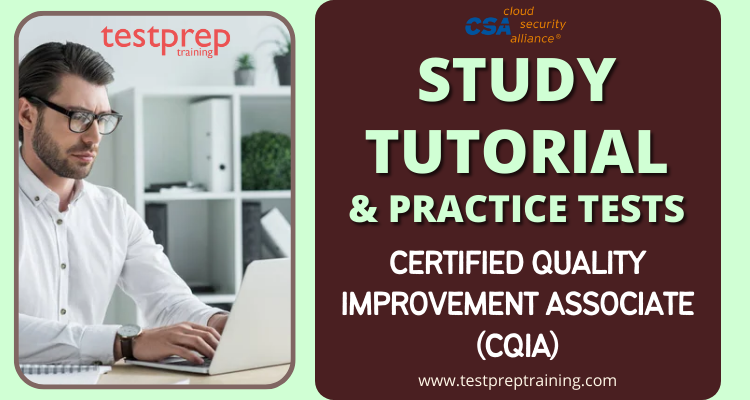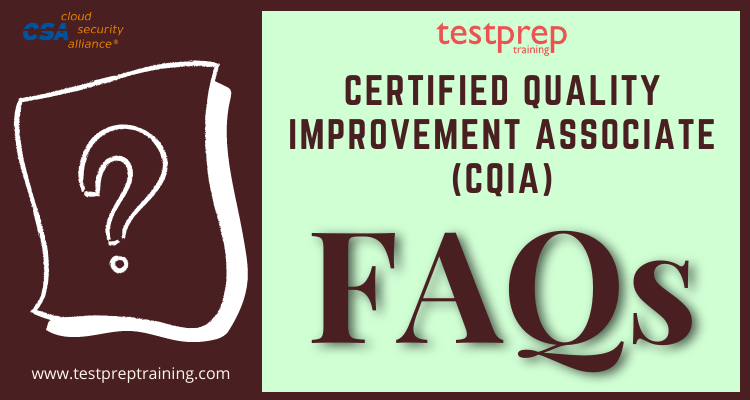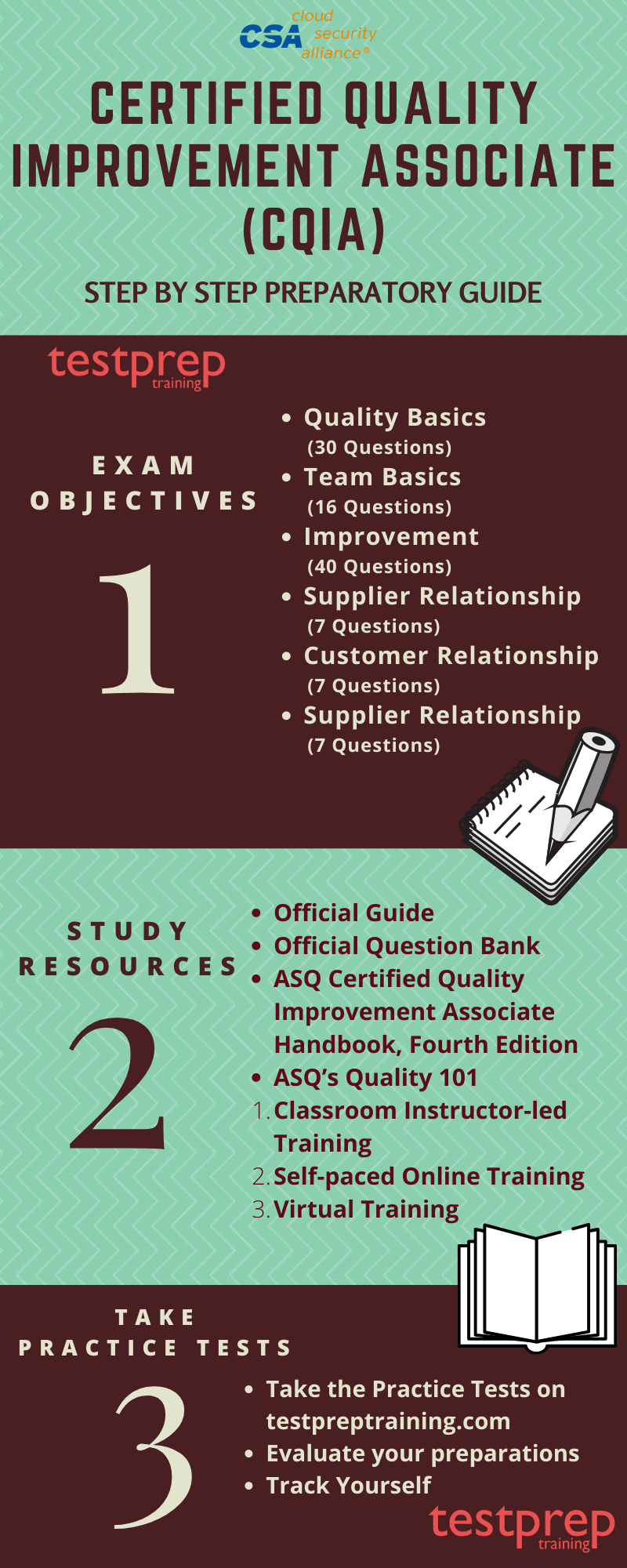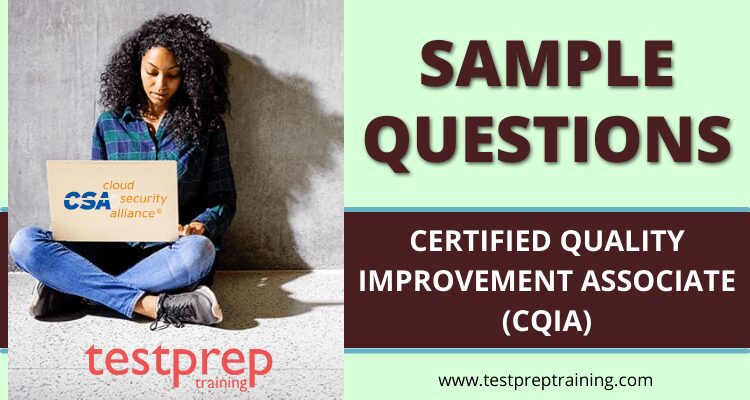ASQ (CQIA): Certified Quality Improvement Associate

As a quality expert, ASQ (CQIA): Certified Quality Improvement Associate certification is a signature mark of quality excellence in many industries. Mastering quality skills enhance your career and your organization’s bottom line. You will be able to demonstrate your commitment to quality and how it will benefit your organization by becoming a Certified Quality Improvement Associate. Generally, Certified Quality Improvement Associates (CQIA) will have a basic understanding of quality tools and their implementation, but they are not necessarily from the traditional quality field. Formal recognition of proficiency in quality and process improvement would be beneficial to those new to quality, process leaders, and those who support business excellence.
Required Education and/or Experience
You must have two years of work experience or an associate’s degree or two years of equivalent higher education.
Core Competencies
- Describing the key events in the evolution of quality.
- Identifying and describing the key components of total quality management (TQM) and understanding how organizations approach TQM deployment.
- Differentiating between the TQM philosophies of six quality experts and two quality approaches are Six Sigma and the Baldrige program.
- Recognizing the relationship between processes and systems and how basic quality tools can be used to assist in improving processes and understanding the role of process management in TQM.
- Defining the different quality concepts that are related to quality evolution, TQM, process management, and basic quality tools.
- Understanding the importance of the customer-supplier relationship along with several team roles and responsibilities as well.
ASQ (CQIA): Certified Quality Improvement Associate Sample Questions
Why take the exam?
- Your skill set improves your chances of landing a position within a modern business environment.
- This a great introduction to quality concepts for people just out of college, switching industries, or entering the quality profession for the first time.
- Managers with CQIA certification earn $98,567 per year on average, compared to $93,037 for non-certified individuals.
Key Market Trends
- Keeping budgets under control while delivering a satisfactory product on time is a challenge for Businesses, which are always in need of Quality Improvement Associates. Therefore, the job prospects prove to be the best for the ones with certification and related work experience.
- In manufacturing and service companies, the cost of poor quality (COPQ) typically accounts for 5-30% of gross sales. According to independent studies, COPQ is a major expense for companies that impacts their profitability, and its reduction can help marginally successful companies transform into profitable ones.
For More Details See: ASQ (CQIA) Certified Quality Improvement Associate FAQs

Course Outline
The Certified Quality Improvement Associate (CQIA) exam covers the following topics:
I. Quality Basics (30 Questions)
A. Terms, Concepts, and Principles
1. Quality definitions
- Describe and distinguish between the common definitions of quality. (Apply)
2. Quality plan
- Define a quality plan, and describe its purpose and objectives to achieve the quality mission or policy.
- Identify the various functional areas and people having responsibility for contributing to its development. (Understand)
3. Quality systems
- Understand the difference and relationship between quality assurance, quality control, and continuous quality improvement. (Understand)
4. Organizational culture
- Understand how culture influences the success of process improvement efforts such as lean, Six Sigma, ISO 9001, Baldrige, and change management. (Understand)
5. Employee involvement and empowerment
- Define and distinguish between employee involvement and employee empowerment.
- Describe the benefits of both concepts. (Understand)
6. Systems and processes
- Define and distinguish between a system and a process and describe the interrelationships between them.
- Describe the components of a system – supplier, input, process, output, customer (SIPOC) – and how these components impact the system as a whole. (Analyze)
7. Variation
- Define and distinguish between common and special cause variation in relation to quality measures. (Understand)
8. Standardization
- Describe how quality systems provide consistency and standardization (e.g. ISO 9001). (Remember)
B. Benefits of Quality
- Describe how using quality tools, techniques, and concepts can improve processes and deliverables (including products and services), and how each benefits all parts of an organization.
- Describe what quality means to various stakeholders (e.g., employees, organizations, customers, suppliers, community, and interested parties) and how each can benefit from quality. (Understand)
C. Foundations of Quality
Understand the key concepts and teachings of the foundational quality thought leaders including:
- 1) Walter Shewhart
- 2) W. Edwards Deming
- 3) Joseph Juran
- 4) Kaoru Ishikawa
- 5) Philip Crosby
- 6) Armand Feigenbaum. (Understand)
II. Team Basics (16 Questions)
A. Team Organization
1. Team purpose
- Describe why teams are an effective way to identify and solve problems, and describe when, where, why, and how teams can be used effectively. (Apply)
2. Types of teams
- Define and distinguish between various types of teams: process teams, continuous improvement teams, workgroups, self-managed teams, ad hoc project teams, cross-functional teams, and virtual teams. (Apply)
3. Value of teams
- Explain how a team’s efforts can support an organization’s key strategies and effect positive change throughout the organization. (Understand)
B. Roles and Responsibilities
Describe the roles and responsibilities of various team stakeholders: (Understand)
- 1. Sponsor
- 2. Champion
- 3. Facilitator
- 4. Leader
- 5. Member
- 6. Scribe
- 7. Timekeeper
C. Team Formation and Group Dynamics
1. Initiating teams
- Apply the elements of launching and sustaining a successful team, including establishing a clear purpose and goals, developing ground rules and schedules, gaining support from management, and obtaining a commitment from team members. (Apply)
2. Selecting team members
- Describe how to select team members based on knowledge, skill sets, and team logistics, such as an adequate number of members in relation to the size or scope of the project, appropriate representation from affected departments or areas, and diversity. (Apply)
3. Team stages
- Describe the classic stages of team development: forming, storming, norming, performing, and adjourning. (Understand)
4. Team Conflict
- Identify the value of team conflict and recognize how to resolve it.
- Define and describe groupthink and how to overcome it.
- Determine how good logistics, an agenda, and effective training facilitate team success. (Analyze)
5. Team decision-making
- Describe and use different decision-making models, such as voting (majority rule, multi-voting) and consensus.
- Use follow-up techniques to clarify the issue to be decided, to confirm agreement on the decision, and to achieve closure. (Apply)
III. Improvement (40 Questions)
A. Process Improvement
1. Six Sigma concepts and tools Compare Six Sigma concepts, tools, and techniques.
- Understand the DMAIC phases: define, measure, analyze, improve, and control. (Understand)
2. Lean concepts and tools
- Compare lean concepts, tools, and techniques.
- Understand lean tools used to reduce waste, including set-up and cycle-time reduction, pull systems (kanban), continuous improvement (kaizen), just-in-time (JIT), 5S, value stream mapping, and error-proofing (poka-yoke). (Understand)
3. Benchmarking
- Define benchmarking and describe how it can be used to develop and support best practices. (Understand)
4. Incremental and breakthrough improvement
- Describe and distinguish between these two types of improvements, the steps required for each, and the type of situation in which either type would be expected. (Understand)
B. Improvement Techniques
Select and utilize improvement opportunity techniques and/or methodologies: (Apply)
- 1. Brainstorming
- 2. Plan-do-check-act (PDCA) cycle
- 3. Affinity diagrams
- 4. Cost of poor quality (COPQ)
- 5. Internal audits
C. Improvement Tools
Select, interpret, and apply the basic improvement tools: (Apply)
- 1. Flowcharts
- 2. Histograms
- 3. Pareto charts
- 4. Scatter diagrams
- 5. Check sheets
- 6. Control charts
- 7. Decision trees
D. Root Cause Analysis
- Utilize root cause tools such as the 5 Whys and fishbone diagram to implement correction and corrective action. (Apply)
E. Risk Management
- Understand the tools and techniques used to identify and communicate risks, including failure modes and effects analysis (FMEA) and Strengths, weaknesses, opportunities, and threats (SWOT).
- Understand prioritization of activities and projects based on risk. (Understand)
IV. Supplier Relationship (7 Questions)
A. Supplier selection
- Identify the supplier selection criteria and approval process. (Remember)
B. Supplier relationship
- Understand supplier relationships, associated challenges, and the effects of a diverse supply base. (Understand)
C. Supplier Performance
- Identify supplier performance measures, including quality performance, on-time delivery, and level of service. (Apply)
V. Customer Relationship (7 Questions)
A. Customer Identification
- Distinguish between internal and external customers. Describe their influence on products, services, and processes. (Understand)
B. Voice of the Customer (VOC)
1. Data gathering and use
- Describe various methods for collecting customer satisfaction feedback, including formal surveys, informal feedback, warranty claims, and focus groups.
- Understand the importance of using customer satisfaction feedback to drive continuous improvement. (Understand)
2. Complaint process
- Define and identify a customer complaint.
- Understand and apply the complaint handling process including documentation, action taken, and providing resolutions to the customer. (Apply)
3. Customer needs
- Understand the key elements of quality function deployment (QFD) and how it identifies and prioritizes customer expectations and needs. (Understand)
Preparation Guide For Certified Quality Improvement Associate (CQIA) Exam

Official Guide
In this exam guide, you get accurate information about the exam course to have a deeper understanding of the course and also familiarise yourself with the course concepts. Prior to beginning the preparation process, you should have a complete understanding of what the exam entails, so the official guide is essential.
Official Question Bank
Using CQIA Body of Knowledge questions, sample exam questions are provided in the Official CQIA question bank. Anyone who wants to prepare for and pursue the CQIA certification should utilize this resource which includes simulated timed exams and review modes. It is important to keep in mind that the questions in this product are not actual ASQ exam questions and your performance on the test simulation is intended for study purposes only, and may not be representative of your performance on an actual certification test.
The ASQ Certified Quality Improvement Associate Handbook, Fourth Edition
The contents and sequence of this handbook correspond to those of the CQIA BoK. Use it as a guide as you prepare for the ASQ (CQIA) examination, and refer to it frequently during the implementation process. ASQ’s experts help you navigate:
- Quality terms, benefits, and philosophies
- Team organization, roles, responsibilities, and dynamics
- Continuous improvement concepts, processes, and tools
- Root cause analysis and risk management
- Supplier and customer relationships
ASQ’s Quality 101
Other training and preparation resources provided by ASQ include the following:
Evaluate with Practice Tests
With hundreds of ASQ (CQIA) practice questions, you can build confidence as you prepare for the exam. Learn about specific topic areas and identify your strengths and weaknesses so you can focus your studies where you need to. You can simulate a timed exam or review specific topics at your convenience.


